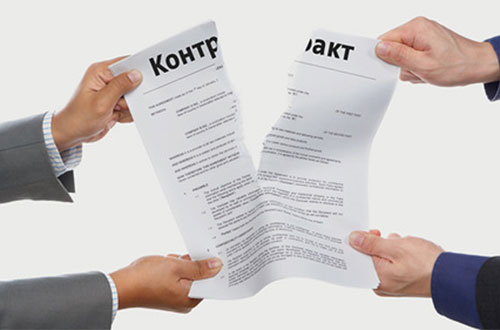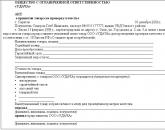Early termination of the lease by the tenant
In the legal literature, a lease is considered an agreement between two parties: the landlord and the tenant, which consists in the provision by the first party on a paid basis of the property specified in the contract to the second party, on the right of temporary use and possession or simply use.
It must be drawn up in accordance with Russian legislation and include all the conditions that are essential to it. Along with a correctly drawn up contract, there are circumstances when the tenant has an urgency to terminate the contract. Let's look at this issue in more detail.
Cases of termination by the tenant
The law provides for several options for terminating the contract initiated by the tenant. It may be terminated in the following cases:
- Firstly when the lease itself includes the terms of an out-of-court settlement of the procedure for terminating the contract. In this case, even at the stage of drafting the project, it provides for the possibility of termination: the notification procedure, terms, possible penalties, the procedure for returning, leased, and others.
- Secondly when the term is not explicitly stated in the lease agreement, then in accordance with Article 610 of the Civil Code, it will be concluded for an indefinite period and easily, perhaps, terminated at the right time. In this case, it will be necessary to notify the landlord of termination one month in advance, and if the contract concerns the lease of real estate, inform three months in advance.
- Third, if there are serious violations of the conditions contained in the contract by the lessor, its action can be terminated in court.
The list of these violations is enshrined in the law, we will consider them in more detail:
- In the event that the landlord creates conditions preventing the tenant from using the rented premises or other property specified in the drawn up agreement.
- If the leased property does not meet the requirements stipulated, in the contract or has any serious shortcomings, the presence of which the lessor knew, but kept silent, and the lessor did not see them during the inspection, making it impossible to use it in accordance with its intended purpose.
- When the landlord does not fulfill his direct obligations for major repairs of the handed over property within the terms stipulated by the contract, or within a reasonable time, if it was not stipulated.
- In a situation where the property owned by the lessor, suddenly becomes unusable, in circumstances where the tenant is not responsible.
Mistakes in drafting a contract
The main mistake, as a rule, is manifested in the preparation of the text of the conditions for the tenant to withdraw from the contract. The contract is signed without thinking about the meaning of the text, or they are unable to correctly comprehend it from the point of view of legal interpretation.
As a result, it turns out that the contract only enshrines the right to express one's desire to terminate, but does not guarantee it in any way.
In this case, termination will be possible only with the consent of the landlord. The court very often considers such cases, where the court is forced to make a legal decision and takes the side of the landlord.
Written in the contract must accurately convey the meaning of the agreed parties.
It is desirable that the right of the tenant of property to early termination of the current contract on his own initiative out of court should be secured. It is necessary to discuss and include in the contract the termination procedure, various material costs, etc. In this way, you can try to protect yourself from litigation.
To avoid this mistake, the wording should be something like this: “In accordance with this agreement, the tenant is vested with the full right to terminate the previously concluded lease agreement without giving reasons at his own request. For its part, the landlord undertakes not to interfere with the termination and voluntarily sign the agreement without going to court.
The effect of the inclusion of a free termination clause is likely to be the lessor's desire to include a clause providing for the payment of a penalty for early termination.
 According to the principle of voluntariness of the contract and its terms, the penalty may be included in the terms of termination, in which case the legality of this clause will have to be challenged in court.
According to the principle of voluntariness of the contract and its terms, the penalty may be included in the terms of termination, in which case the legality of this clause will have to be challenged in court.
Or, if the tenant initially agrees to pay, you can record this as any other termination compensation. This will be the most correct solution.
If the penalty was not spelled out in the contract and the landlord made such demands, it will be important to refer to the current legislation, which provides for a penalty as compensation for breach of contractual obligations.
In this case, there can be no talk of it, because voluntary termination will be provided for by the contract itself, which means that there is no violation of obligations.
This issue should be resolved "on the shore", otherwise you still have to go to court and prove the illegality of this claim of the landlord.
It is also worth noting the following feature regarding the duration of the contract.
It is important for the tenant to know that a lease agreement drawn up for a period exceeding one year requires state registration.
And this further complicates the termination process, since it will be necessary to apply for termination of registration. Also, the transaction becomes completely transparent. Therefore, many tenants indicate a period not exceeding a year, after which they draw up and sign a new contract.
For the tenant, it is most advantageous to persuade the landlord into a contract without specifying the validity period, then you will not have to resolve this issue at all, since the termination will be enshrined in law.
Notification by letter of termination of the contract by the tenant
If the landlord fails to fulfill its direct obligations arising from the lease agreement, the law provides for the procedure for notifying the first by means of a notification.
Such a notice is handed in personally, sent by registered mail with a description of the attachment, or delivered to the office in two copies, on each of which the receiving party puts the date, his signature and, if necessary, the seal of the organization, registers as incoming in his journal.
The written notice must contain:
- name and details of the person or the lessor's organization to which it is addressed;
- details and contact details tenant;
- link to the contract rent;
- the requirements themselves and the deadlines for their implementation.
If the landlord did not respond in time or did not fulfill his obligations, you should send a second notice of the forced termination of the contract unilaterally. Such a notice is sent in situations where the tenant himself wanted to terminate the contract.
Termination of the contract by the tenant
Termination occurs by drawing up and signing between the tenant and the landlord a new termination agreement and an act of return (transfer) of the premises to the landlord. Such an agreement must be drawn up in writing and include: name, date and city of drawing up, details of the landlord and tenant, indicate the contract in respect of which it is drawn up. It should also have a description of the lease object, reflect the essence of the agreement, indicating the grounds on which the agreement is terminated, references to the law.
Sample
Agreement No. 002
On termination of the residential lease agreement to agreement No. 001 dated July 33, 2015
Moscow
January 15, 2016
Ivanov Inokenty Karpovich, born January 1, 1950, passport series 5454 number 076538, Moscow, Lenin street, house 09, apt. 080 (hereinafter referred to as the "Lessor") and Parovozov Semyon Grigorievich born on 01.11.1975, passport series 0892 number 546372, Krasnodar, Khakurate st., 18 apt. 50 (hereinafter referred to as the “Lessee”), hereinafter referred to as the Parties, have entered into this agreement as follows:
- Terminate the lease agreement for residential premises No. 001 dated July 33, 2015, Moscow (hereinafter referred to as the Lease Agreement)
- All main obligations of the acting Parties under the Lease Agreement terminate at the time of signing this agreement, including the payment of utility bills.
- This agreement is simultaneously a transfer act (return) of the rented premises to the Lessor. By signing it, the Lessor accepts the premises, thereby confirming that its technical and cosmetic condition fully complies with the Lease Agreement.
- This document will come into force from the moment of its mutual signing by all Parties.
- The Agreement was drawn up in two completely identical copies, one for each Party.
Signature And:
__________________ /_________/________
Notes
- In the agreement itself, you can not indicate that it is also an act of the return of the leased premises, but draw up a separate act. In the agreement itself, indicate that it will come into force from the moment the two documents are signed by the parties.
- If the lease agreement specifies a period of more than a year, then the agreement will need to be drawn up in three completely identical copies: one for one party and one for the registering authority, since such an agreement is subject to registration in the registry and the agreement will also have to be registered.
- At the end of the contract, you must enter the full name, signature and date, because the date of the agreement may not coincide with the date of signing, and, accordingly, the return of the premises.
- If one of the parties to the agreement is a legal entity, then you need to put a seal, and enter the details.
Popular
- How to get a TIN: possible ways
- What kind of business can you do?
- Written notice of termination of the lease
- Business from scratch. Things to do?
- Cost of goods sold: formula, methodology and calculation example
- How to write a vacation application - examples
- What kind of business can be opened in a small town or village?
- The formula for calculating the cost of services, products sold and total cost
- Sample memorandum: I bring to your attention
- Example of an explanatory note for being late for work




